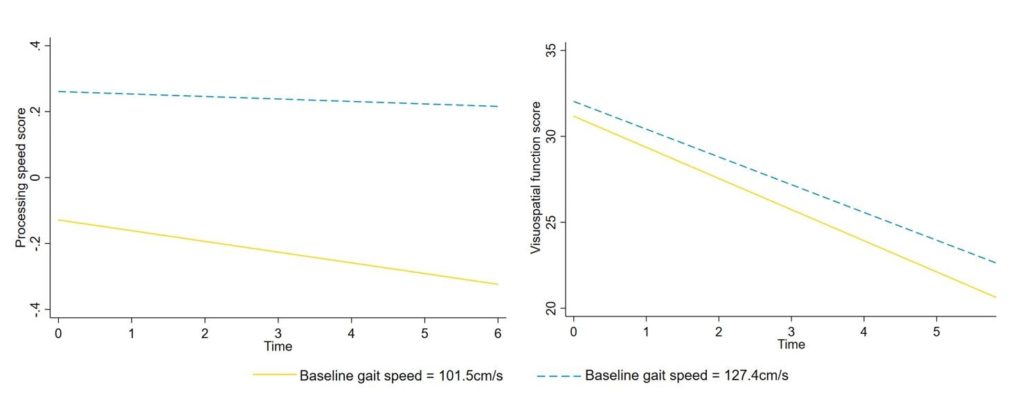By Oshadi Jayakody
Dementia is the largest cause of disability in older people. Currently, there is uncertainty about who will develop dementia. Imaging biomarkers are promising for predicting dementia, but they are costly and unable to capture the role of cognitive reserve (brain’s ability to improvise to get a job done). A person’s gait may reflect the ability to use brain networks in the presence of pathology. Poorer gait performance (e.g. slow speed or increased gait variability) predicts future dementia. This study aimed to determine if specific gait characteristics are associated with decline in specific cognitive domains. This information may help targeting individuals with personalised interventions at an early stage.
Our sample (n=410, mean age 72.0±7.0) was randomly selected from the Australian electoral roll. We assessed gait at baseline using a GAITRite walkway to obtain gait speed, gait variability (step length, double support time [DST], step time and step width) and walking speed reserve (fast pace-usual pace). We tested cognition (processing speed, memory, executive and visuospatial function) with neuropsychological tests at three time points over 4.5 years. We used longitudinal mixed effect models to identify gait characteristics that predict cognitive decline over time. Additionally, we included an interaction between APOE4 genotype and each gait measure to determine if APOE4 modified any associations. APOE4 is a genetic risk factor for Alzheimer’s disease. Our purpose was to examine if having both poorer gait and APOE4 results in greater decline in cognition. We found that specific gait measures were associated with decline in specific cognitive domains. For example, greater variability in DST predicted memory decline, whereas slow speed predicted decline in processing speed and visuospatial function (top figure). Interestingly, slow speed only predicted memory decline in people with APOE4 (bottom figure).
Our findings suggest gait is a useful functional marker of cognitive decline that could be incorporated into clinical assessments of cognition and dementia risk. Gait speed is quick and easy to measure. Measuring DST variability gives additional information on those at risk of memory decline and therefore may be suited for specialist clinics. A limitation of this study is that we did not include dual-task walking which is also known to be associated with dementia.
Identifying people at risk of cognitive decline as early as possible may provide a window of opportunity to combat accumulating pathology or initiate preventative interventions. Future work is required to determine cut points for gait measures to facilitate use in clinical practice.


Figure -top. The association between baseline gait speed and; left) processing speed; right) visuospatial function over time (6years) ; Differences in change in processing speed and visuospatial functions are shown for the highest (faster) and lowest (slower) quartiles of baseline gait speeds.
Figure -bottom. The association between baseline gait speed memory over time (6 years) in people with and without APOE4. Differences in change in memory are shown for the highest (faster) and lowest (slower) quartiles of baseline gait speeds combined with APOE4 genotype.
Publication
Jayakody O, Breslin M, Srikanth V, Callisaya M(2019) Gait Characteristics and Cognitive Decline: A Longitudinal Population-Based Study. Journal of Alzheimer’s Disease, 1-10. DOI: 10.3233/JAD-181157
About the Author

Oshadi Jayakody
Menzies Institute for Medical Research, University of Tasmania, Australia
I am a final year PhD candidate at Menzies Institute for Medical Research, University of Tasmania. I am working with Assoc. Prof. Michele Callisaya and my PhD aims to understand the interplay between gait, cognition and brain structure in predicting falls and dementia in older people.
Copyright
© 2020 by the author. Except as otherwise noted, the ISPGR blog, including its text and figures, is licensed under a Creative Commons Attribution-ShareAlike 4.0 International License. To view a copy of this license, visit https://creativecommons.org/licenses/by-sa/4.0/legalcode.
ISPGR blog (ISSN 2561-4703)
Are you interested in writing a blog post for the ISPGR website? If so, please email the ISGPR Secretariat with the following information:
- First and Last Name
- Institution/Affiliation
- Paper you will be referencing


